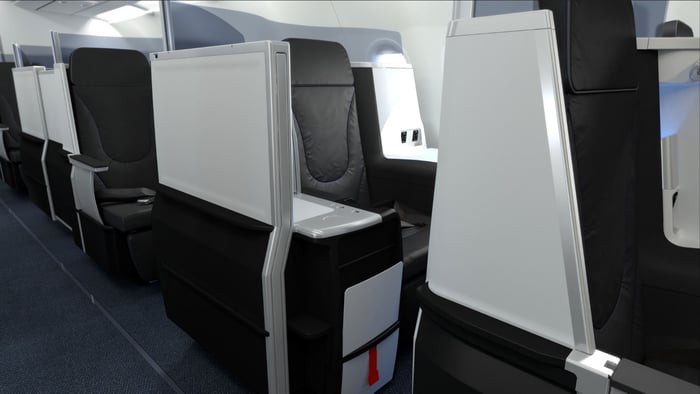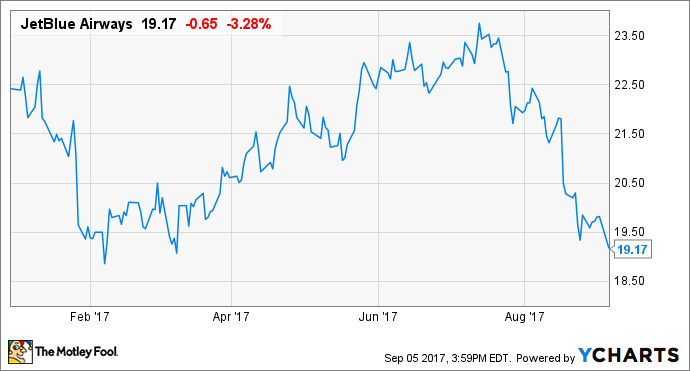In late July, JetBlue Airways (JBLU -4.07%) reported very strong results for the second quarter of 2017. The carrier did benefit significantly last quarter from the timing of Easter, but its underlying revenue and cost performance is improving as well.
Nevertheless, JetBlue Airways stock has fallen by about 20% since mid-July. Investor worries about rising fare competition in the airline industry have driven the bulk of this decline. Earlier this week, Delta Air Lines' (DAL -0.47%) Q3 guidance cut caused JetBlue Airways shares to fall even further. This is creating a great buying opportunity for long-term investors.
JetBlue Airways stock YTD performance. Data by YCharts.
JetBlue's unit revenue is recovering
In the first half of 2017, JetBlue's revenue per available seat mile (RASM) rose 1.2% year over year. A 7% surge in RASM last quarter more than made up for a 4.8% decline during the first quarter of the year.
As of early August, JetBlue expected its positive revenue momentum to continue in the third quarter. The midpoint of its guidance calls for RASM to increase about 1% year over year. This position shows that the capacity adjustments implemented earlier this year, when unit revenue was falling short of expectations, are bolstering JetBlue's RASM performance as intended.
Should investors worry about weakness at other carriers?
On Tuesday, Delta Air Lines cut its Q3 margin guidance by about 2 percentage points. It blamed this decision in part on a slower-than-expected recovery in fare levels for last-minute domestic bookings. Two months ago, Delta had expected to post strong 2.5%-4.5% unit revenue growth in the third quarter; now it expects a more modest 2%-3% increase.
JetBlue Airways stock plunged more than 3% on Tuesday, indicating that investors see Delta's guidance cut as a big red flag. However, JetBlue is much more focused on carrying leisure traffic than Delta is. Most airline tickets for leisure travel are booked far in advance, which should help JetBlue meet its unit revenue guidance for the third quarter.
In addition, JetBlue is set to get a unit revenue boost from the expansion of its popular Mint premium transcontinental service. Mint was initially introduced to help JetBlue compete better on the crowded New York-Los Angeles and New York-San Francisco routes. However, it was so successful that JetBlue is expanding Mint to many other long-haul markets.

JetBlue is set to rapidly expand its Mint premium service. Image source: JetBlue Airways.
Earlier this year, JetBlue converted its Fort Lauderdale-Los Angeles and Fort Lauderdale-San Francisco routes to Mint service. It also recently upgraded its New York-San Diego flights to Mint. Five more routes are scheduled to get Mint service by next April. So far, JetBlue has generated strong RASM growth wherever it has rolled out the premium Mint product. The rapid expansion of Mint should thus help JetBlue offset industry revenue headwinds.
Lastly, JetBlue doesn't operate many flights to the hub cities, such as Chicago, Denver, Houston, and Newark, that have seen the most fare competition recently. It has experienced some pressure on its routes between the Northeast and Florida, but JetBlue's geographical focus is insulating it from the worst of the industry fare wars right now.
Cost creep is about to stop
On the cost side, the outlook for JetBlue is even stronger. While non-fuel unit costs jumped 4.2% year over year in the first half of 2017, JetBlue is in the early stages of a major multiyear cost-cutting program. From 2018 to 2020, the company expects non-fuel unit costs to rise no more than 1% annually on average.
Furthermore, JetBlue is in the final stages of a comprehensive fleet review. There is a strong likelihood that it will decide to accelerate the retirement of its 100-seat E190 fleet, which has had disappointingly high unit costs. It could either become an all-Airbus carrier again, upgrade to the next-generation E190-E2 (or its larger sibling, the E195-E2), or switch to Bombardier's new CSeries jet for "thin" routes.
Any of those options would lead to a significant long-term reduction in unit costs for JetBlue, after a large one-time charge for the existing E190 fleet. This cost savings would come on top of JetBlue's other efforts to enhance productivity.
JetBlue Airways stock now trades for less than 10 times earnings, even though the company has numerous attractive growth opportunities. Investors appear to be overreacting to bad news elsewhere in the airline industry. Their doing so makes JetBlue stock a better buy than ever.





